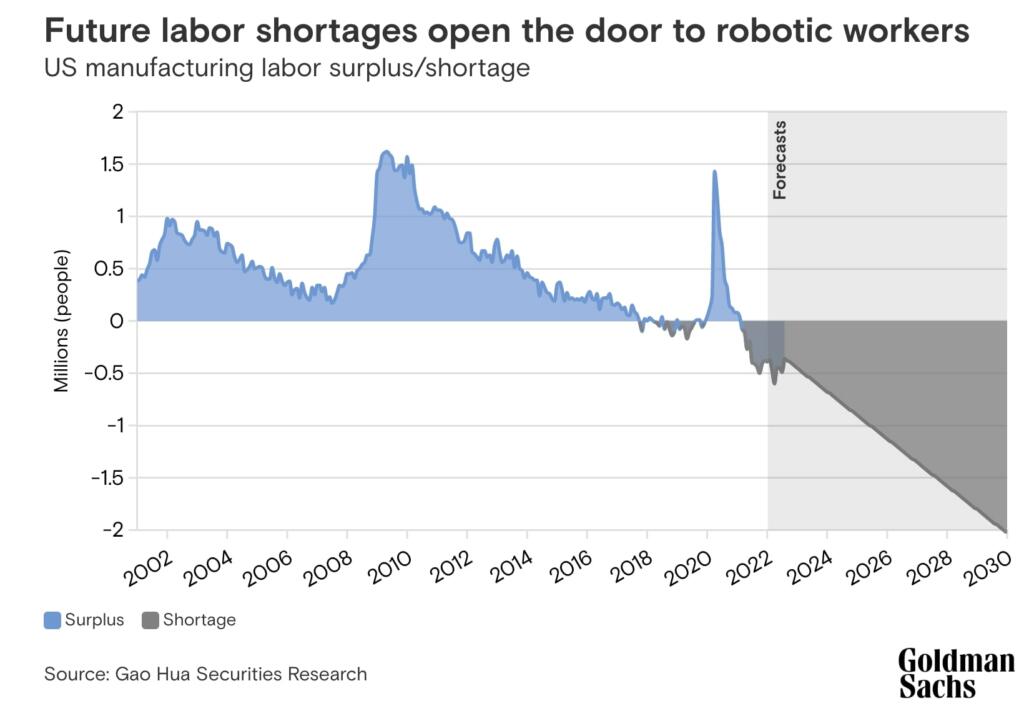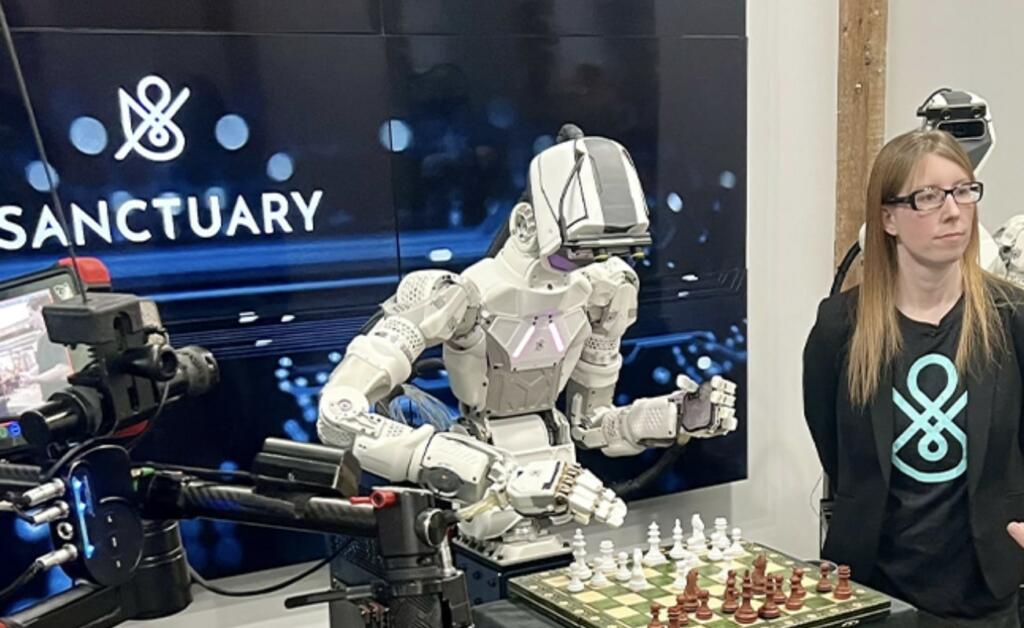Goldman Sachs Research estimates a $6 billion market (or more) in people-sized-and-shaped robots is achievable in the next 10 to 15 years. Such a market would be able to fill 4% of the projected US manufacturing labor shortage by 2030 and 2% of global elderly care demand by 2035.
GS Research has an upside scenario where product design, use case, technology, affordability and wide public acceptance are completely overcome. Goldman Sachs Research see a market of up to US$154bn by 2035 in a blue-sky scenario. This larger market penetration would fill from 48% to 126% of the labor gap, and as much as 53% of the elderly caregiver gap.
This would be a need for 3-5 million humanoid robots in the USA alone by 2030.

Tesla Teslabot, SanctuaryAI, Figure.ai, Engineering Arts Ameca robot, Xiaomi’s CyberOne, Agility Robotics Digit, Boston Dynamics, 1X Technologies and others are competing to make humanoid robots.
Above are the Teslabots

Sanctuary AI

Figure.ai
https://t.co/6znRJJUF4K Ameca languages and translation – This demo shows multiple language support on the #ameca platform using #gpt3 for conversation and translation, DeepL for language detection, and Amazon Polly neural voices for speech generation
— Ameca The Robot (@AmecaTheRobot) April 13, 2023
CYBORG SOCIETY TRAILER: Documentary from Free Turn Entertainment about Ameca as she ‘plugged in’ to ChatGPT https://t.co/aig2HVK3tW
— Ameca The Robot (@AmecaTheRobot) April 26, 2023
Xiaomi launches CyberOne, a full-size humanoid robot. (Xiaomi) #Robots #Robotics #Innovation pic.twitter.com/wRGULaKYNt
— James Gingerich #B2B #Technology #Influencer (@jamesvgingerich) April 29, 2023
Digit, the first commercialized humanoid robot by Agility Robotics.
👉 awesome pic.twitter.com/dpHF8mwmo6
— Ezer (@EzerRatchaga) March 21, 2023
Here's my conversation with Robert Playter, CEO of Boston Dynamics, a legendary robotics company that over 30 years has created some of the amazing robots ever built, including the humanoid robot Atlas and the robot dog Spot. This was fascinating! https://t.co/gMISBVwh1R pic.twitter.com/u5QYgQV1AC
— Lex Fridman (@lexfridman) April 28, 2023
1X Technologies got $23M from OpenAI. OpenAI is the multi-billion dollar company behind ChatGPT and GPT-4.

Brian Wang is a Futurist Thought Leader and a popular Science blogger with 1 million readers per month. His blog Nextbigfuture.com is ranked #1 Science News Blog. It covers many disruptive technology and trends including Space, Robotics, Artificial Intelligence, Medicine, Anti-aging Biotechnology, and Nanotechnology.
Known for identifying cutting edge technologies, he is currently a Co-Founder of a startup and fundraiser for high potential early-stage companies. He is the Head of Research for Allocations for deep technology investments and an Angel Investor at Space Angels.
A frequent speaker at corporations, he has been a TEDx speaker, a Singularity University speaker and guest at numerous interviews for radio and podcasts. He is open to public speaking and advising engagements.


I invest in the industry and those most closely tied to it, not so much in individual companies that make robots, because, as Peter Lynch pointed out, invest in a company that makes the best doodad and the next day some other company may roll out a better one. You want to invest in companies that will do better as doodads get better, because, regardless of who makes them, doodads will get better.
Watching my grandchildren go from being stuck on their backs to stand upright and then to walk and to run, I expect that the mastering the human form will quickly become relatively easy for robots and will give them to access to a great many activities we will want them doing.
Among other things, they could operate any piece of heavy machinery when their own bodies aren’t enough. Yes, they could probably do it remotely as well, but as a humanoid they could climb out and open an access panel and repair or replace something, or guide human children out of the field they are trying to plow, or run into a burning building to rescue someone, or a million other things that we would take for granted that a human could do. But that a specialized robot form might not be able to do.
The only way a robot form could be more flexible than as purely humanoid would be if it could also change shape into additional forms, but don’t make them too big, because then all you have is a silly Transformer. We tend to outgrow them pretty quickly and, besides, making them might attract decepticons.
The future is awareness – You couldn’t be more wrong.
Humanoid robots ARE the flexible ones, it’s the industrial ones that are rigid.
You can have them unload the truck, then stock the shelves…effortlessly. Are world is built by us, for us. So If a robot is the same size, they can easily fit through doorways, open doors, walk in aisles with a bunch of people in it shopping. It’s the best “one size fits all” approach to robotics. Eventually we will see custom robots, that are designed for specific tasks, like a construction robot with 4 arms, but it will still keep the human form, and be bipedal.
Your hatred of Elon is clouding your judgement.
Thats an excellent answer, thankyou. I was wondering why, if designing from scratch, use a humanoid outline. Does it really need a head? Would reversed knees be a better solution? I hadn’t considered that the world is already designed for that configuration, so lets stick with that for now.
I agree that they’ll keep a form factor scaled to humans, but I can also see advantages, both in stability as well as acceptance if robots have quadrupedal base. The stability is obvious, and I think advantageous in the ability to lift objects and people (healthcare), and allows doesn’t use as much energy or computational power to maintain it’s balance.
The acceptance is speculative, I think that we may find another ‘uncanny valley’ with robots that are too, but not quite enough human in their interactions. We interact with many different four footed animals that share our human designed spaces, that we don’t expect to act ‘human’, although many people anthropomorphize their behavior.
So maybe instead of a bipedal base, a standard quadrupedal base about the size of a German Shepard with interchangeable torsos?
While a quadrupedal base has the advantage of potential static stability, the truth of the matter is that software is cheaper than hardware at volume, and you can dynamically balance a two legged robot cheaper than you can add two legs, at production volumes. At this point, bipedal locomotion is largely a solved problem.
Further, quadrupeds are kind of handicapped at climbing ladders, traversing narrow confines, and so forth.
If you’re really concerned with saving energy, build a biped and use powered roller skates for feet, permitting it to roll around where the surface permits. That would probably be energetically efficient enough to justify the minor increase in hardware cost.
Industrial robots are fine and are progressing. Humanoid Robots is another Elon Musk Hallucination derived from his spending his autistic childhood reading science fiction books that his followers are faithfully absorbing. Humanoid Robots are too rigid in form and cannot compete with the flexible functionality of industrial robots.